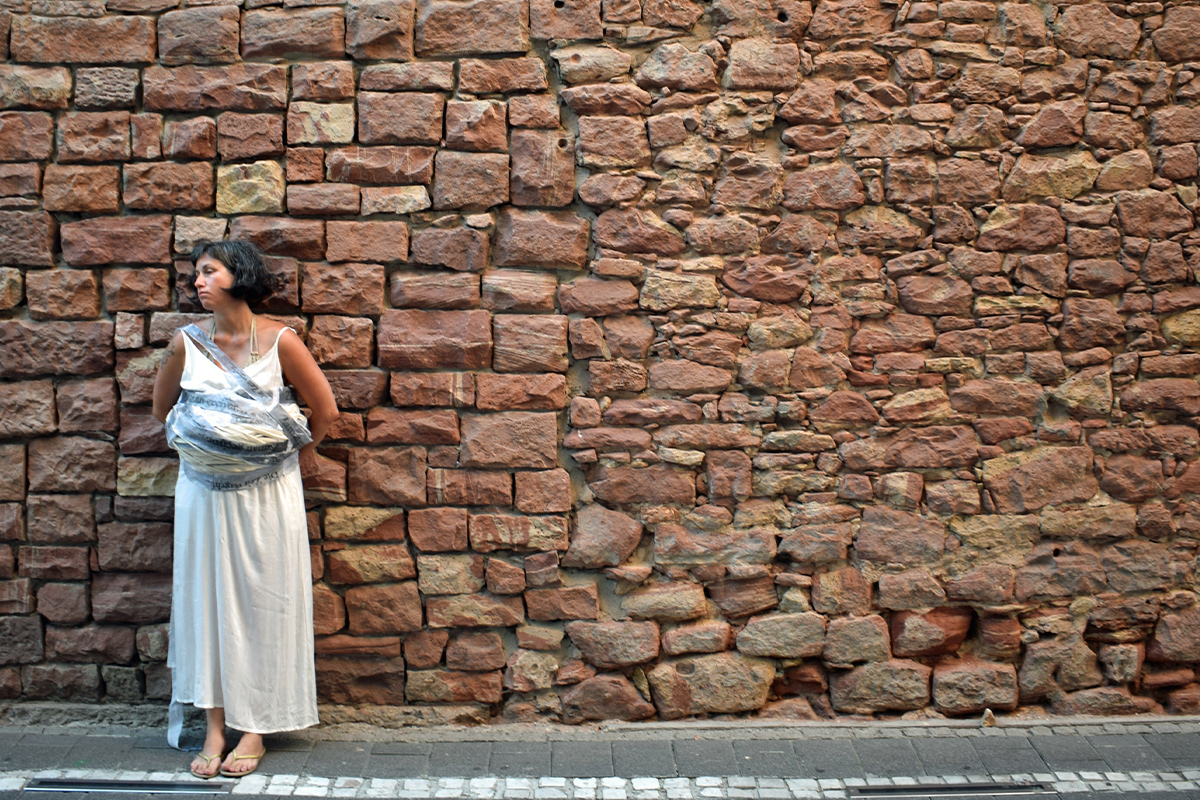On July 23, 2021, Israeli performance artist Adi Liraz roamed the German city of Offenbach am Main. As evening light waned on the late summer Shabbat, Liraz, adorned in a long garment she calls a “History Dress,” carried a lamp in each hand. A passage from the proverbs of Solomon, printed in Hebrew on the dress’s fabric, read, “Who will find this strong woman?” — a nod to the city’s history as a center of early 20th century Hebrew-language press.
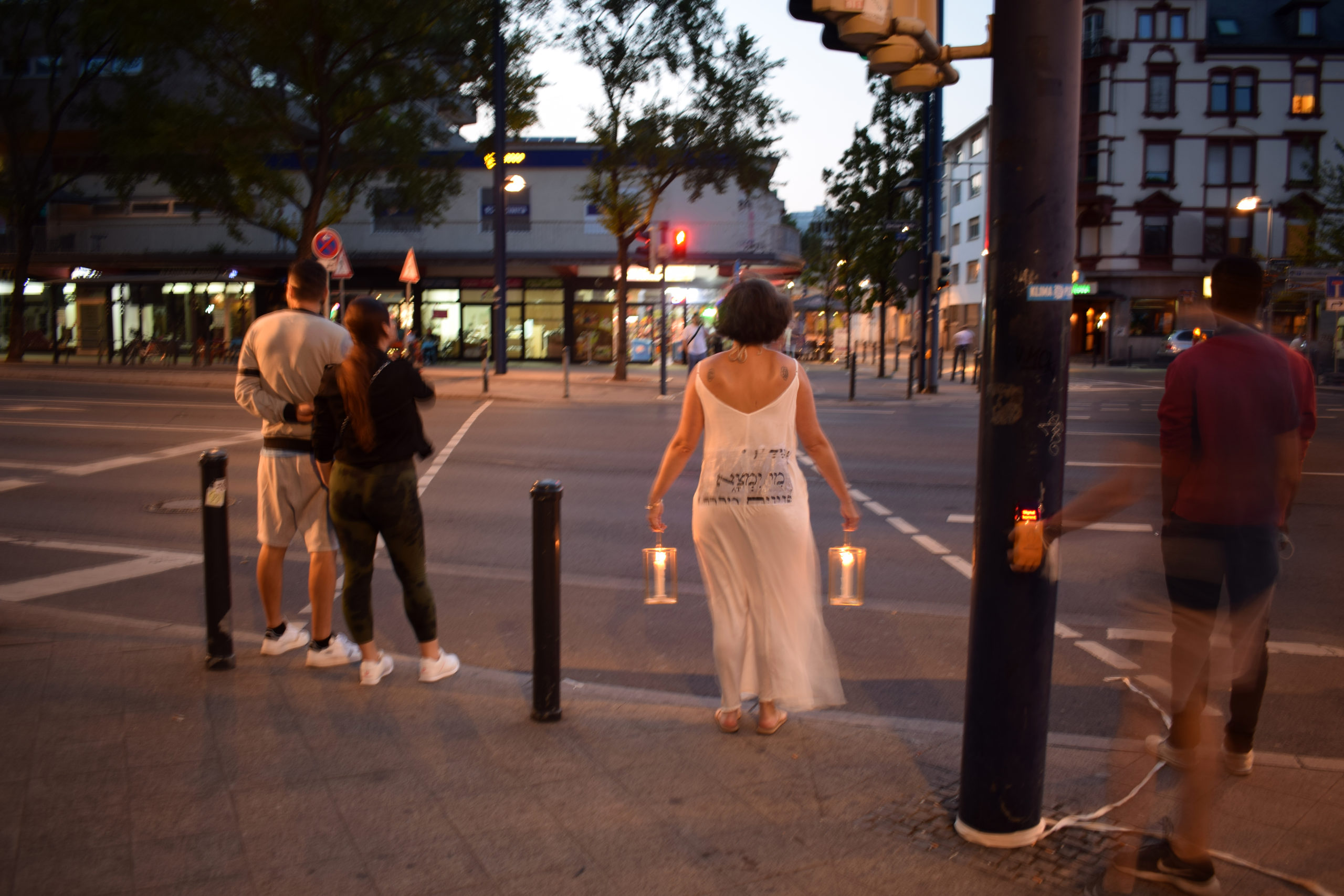
Around her core, Liraz had wrapped 650 meters of parchment-like textile, inscribed with the poetry of the late Semra Ertan who, in 1982 at age 25, burned herself alive to protest the racism she experienced as a Turkish guest worker living in Hamburg, Germany.
Liraz placed strips of the text of Ertan’s collection, “My Name Is Foreigner,” throughout Offenbach am Main during her performance. She stopped by the city’s old synagogue to touch its stone and gaze at the high walls that stand as a testament to genocide. A passage of Ertan’s poetry read, in German, “Forget the unforgettable” (“Vergessen, das Unvergessliche”) as Liraz reached the Main River, where a nearby sign indicated 17 kilometers to the town of Hanau. There, a far-right domestic terrorist killed 11 people, all ethnic minorities, at two hookah bars in February of 2020.
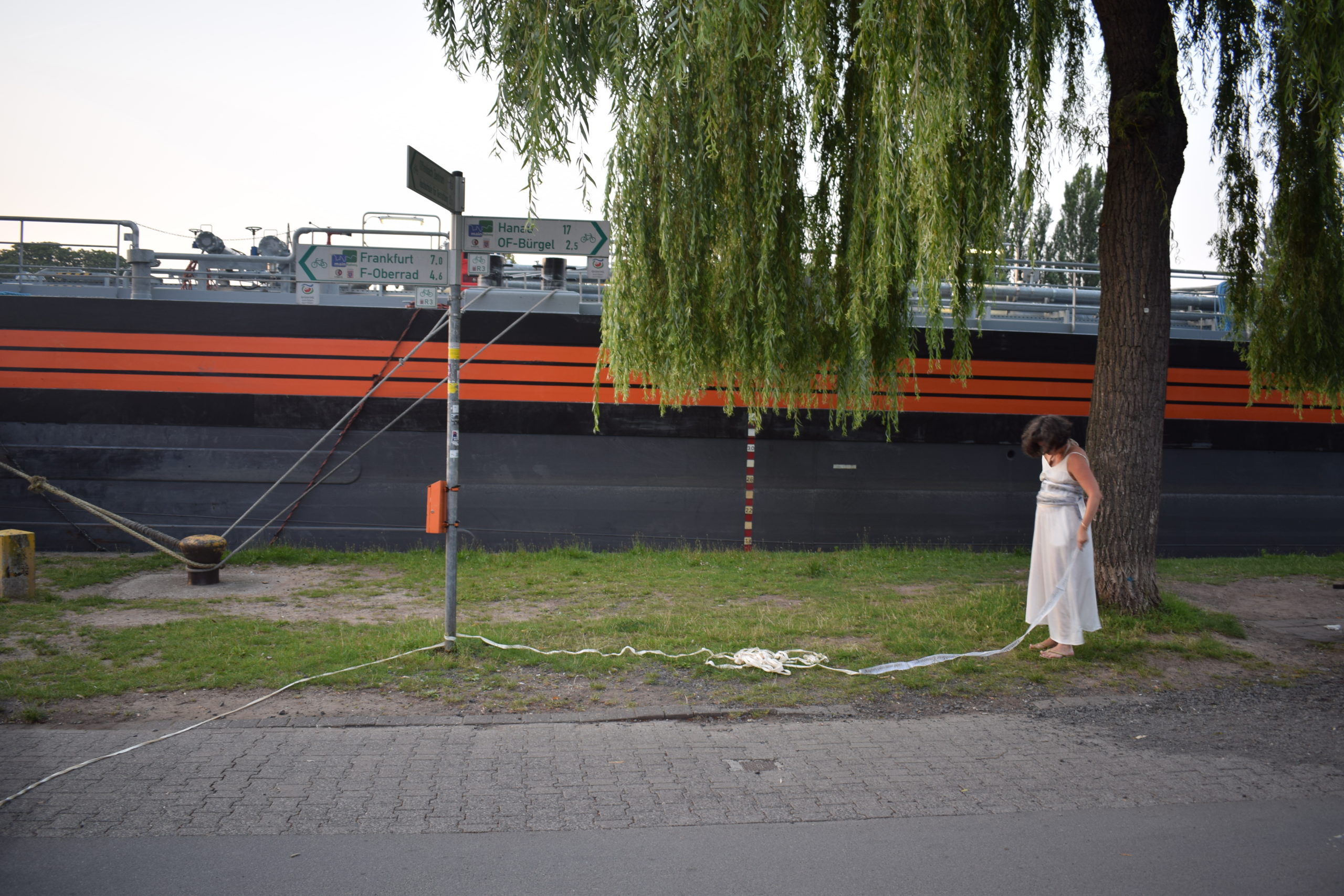
This performance, “MeMayim LeEsch” — “From Water to Fire” — was produced as part of the Chai Jewish Cuture Festival in Offenbach. As in much of the Berlin-based artist’s work, textiles and texts combine with location to tell a story of place-based memory. Liraz is Jewish, and though not all of the histories she evokes are personal Jewish ones, many are. In earlier pieces in Ioannina, Greece, Liraz enacted the story of her great-aunt who perished in Auschwitz during the Holocaust.
“Asking for Nelly” (2019), a durational performance walk, began with Liraz standing in the center of Ioannina’s popular lakefront square, in full view of the university town’s evening crowds, adorned in another “History Dress,” itself a memorial archive stitched in collaboration with art students from the University of Ioannina. Liraz narrated her family history with its thread, and stained the fabric with red and yellow dye during storytelling performances.
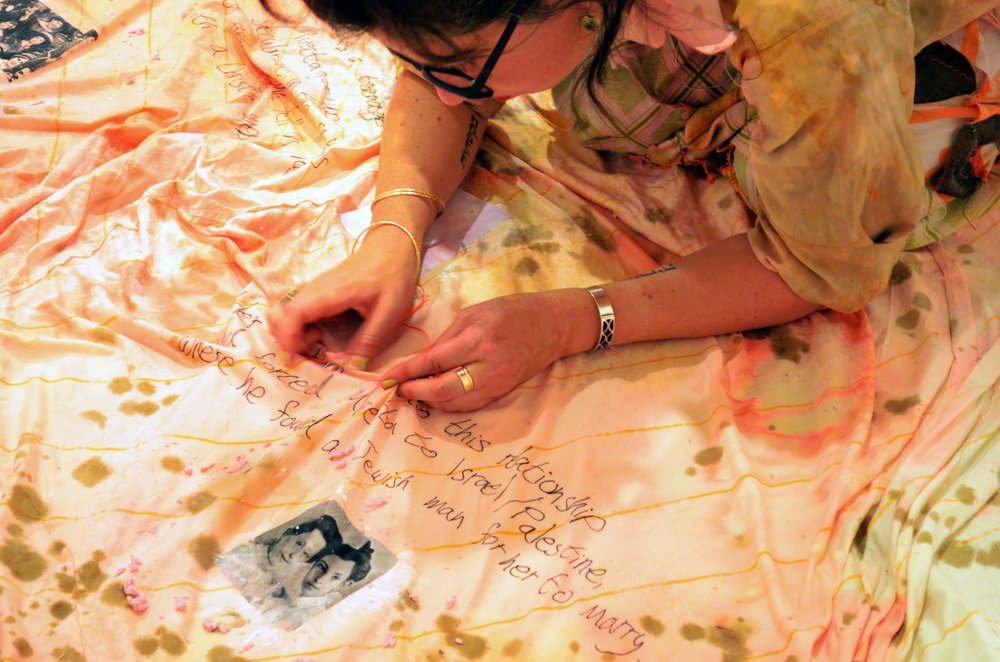
The idea that history is wearable is part of Liraz’s performance art vocabulary, in which she is weighed and enveloped by the past. During “Asking for Nelly,” she held a projector at belly-height which beamed her great-aunt’s portrait, blinding onlookers while illuminating her path to a house where, exactly 75 years prior to the day, Nazis deported Nelly.
Nelly was one of the 1,960 Jews deported from Ioannina by Nazis on March 25, 1944, and among the 1,759 Ioannina Jews murdered at Auschwitz. Three quarters of a century later, her sister’s great-granddaughter would flash the image of her face where she was taken from home, let her History Dress fall to her ankles, and leave the clothing at her doorstep, flanked solemnly by public observers, including members of Ioannina’s 35-strong remaining local Jewish community.
Three months after her performance of “Asking for Nelly,” Liraz returned to Ioannina for the installation piece “ReMembering,” inspired by antique sewing machines she found by the women’s entrance to the Old Synagogue. Women who were among the 110 Jews of Ioannina who survived the Holocaust had used them to make a living when they came back to homes that were sometimes occupied by people who would not hear or believe their stories.
In a follow-up piece, titled “Textured (Hi)Stories II: ReMembering,” Liraz sprawled textile works throughout the Mekeio Boarding School for Girls, now the Mekeio Foundation, which has taught sewing, knitting and loom weaving to underprivileged girls in Ioannina since 1908. Hanging from the ceiling, the train of a mottled dress encircled the floor, where texts, photographs and sewing machines once left to rot in the back of the Old Synagogue were scattered.
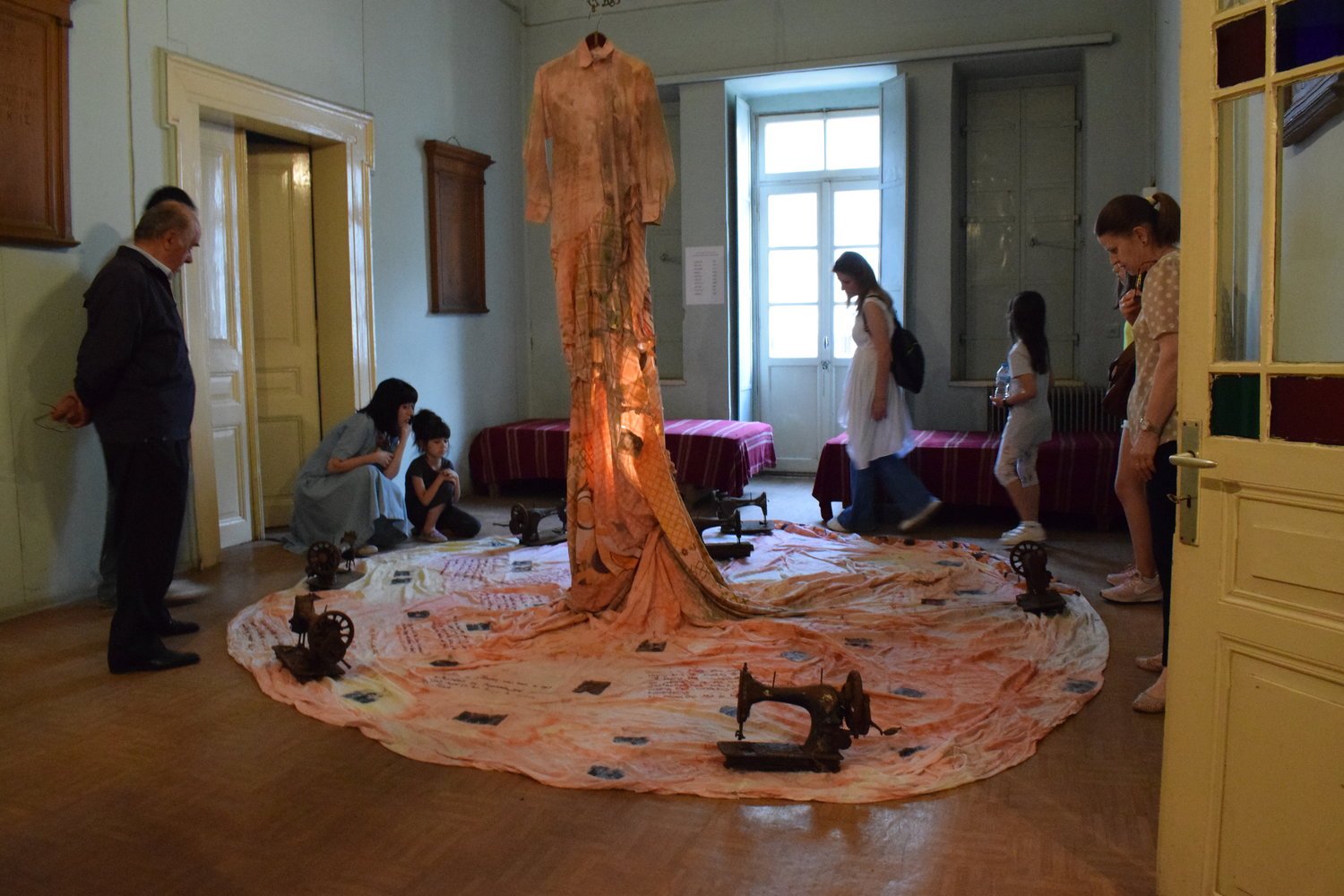
“ReMembering” wound through the Mekeio, its musty cellars filled with dresses and textiles suspended between single threads like human spiderwebs. But Liraz didn’t just showcase the textile craft of Jewish women in Ioannina; she also foregrounded their voices. As part of “ReMembering,” she filmed seven Romaniote women, mostly from Ioannina, and projected their interviews at the Mekeio Foundation in June of 2019. Liraz asked them about their relationship to textiles, their educations, their families, their lives. She stitched her reflections on hearing them into one of the exhibition’s History Dresses: “Women in my family were often being silenced. But they told their stories by creating different kinds of text, passing on the tradition of the craft of textile work. They narrated with symbols.”
In Germany, Liraz has developed her textual, textile symbology further to encompass three minority women poets while memorializing sites of racist violence. Ertan is one of them. Later in July 2021, in Rostock, Liraz performed her latest public work, “All memories flow into the sea (and out again).” This piece interwove the writing of two other German-speaking female poets: May Ayim, who pioneered Afro-German literature before dying by suicide in response to the racism she experienced throughout her life as a Black poet in Germany, and Jewish poet Rose Ausländer, who passed away in 1988 in Düsseldorf after a long life as a voice of survival during Germany’s struggle toward denazification.
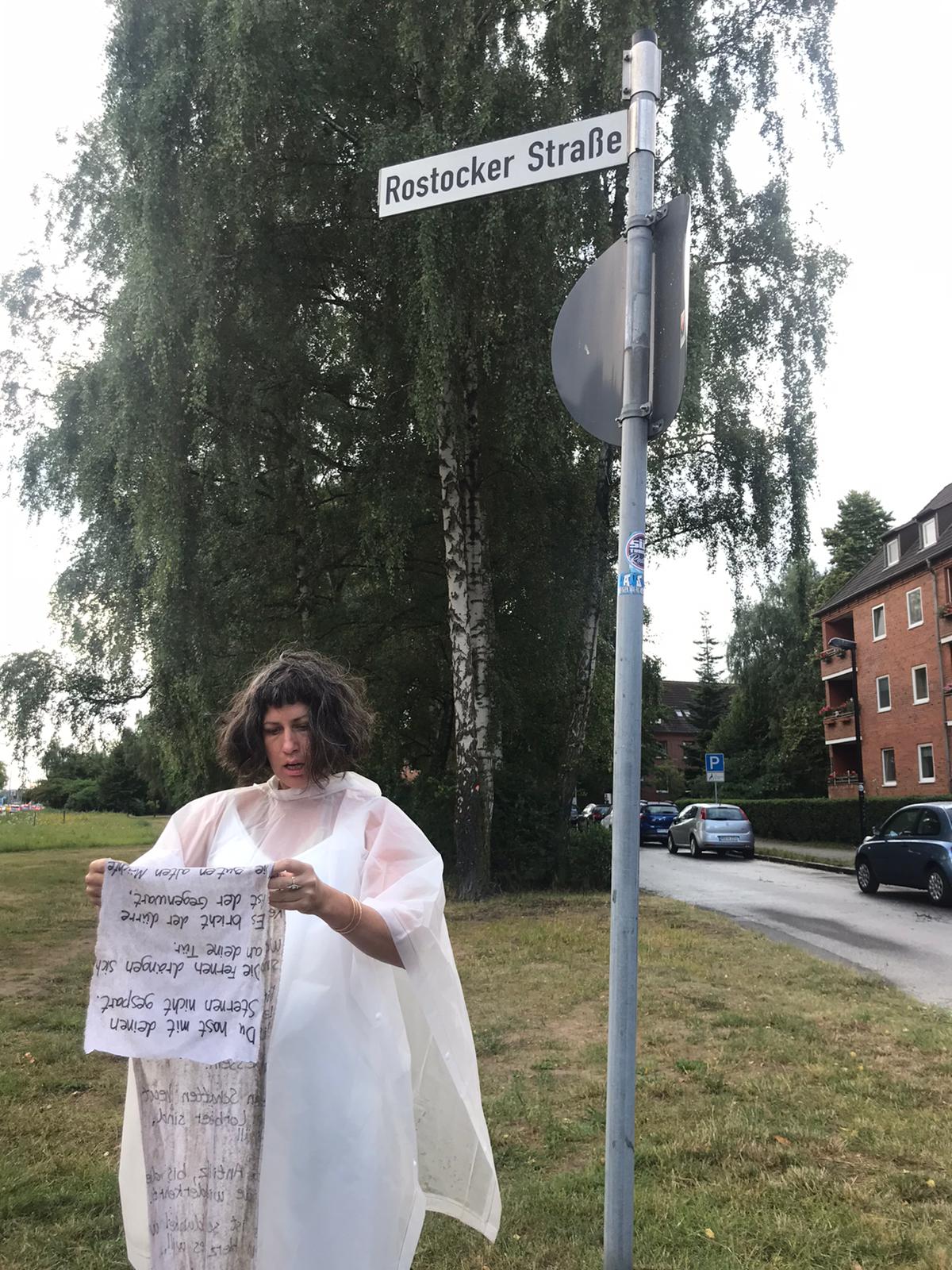
As evening fell on Saturday, July 31, a small contingent followed Liraz as she emerged from the sea to read the poems of Ertan, Mayim and Ausländer from waterlogged textile paper strewn outward from the hems of her dress.
“We don’t realize whether we’re still alive or dead / We’re floating between fish and colors in an anonymous year,” Ausländer wrote in her poem “Between Fish and Color.” These lines reminded me of Ralph Ellison’s “Invisible Man” metaphor for Black life in America. And it is no coincidence that the name of Ertan’s poetry collection, in German, is “Mein Name ist Ausländer,” Ausländer meaning “foreigner.”
In the midst of her performance, as Liraz’s audience picked up the watery poems from the ground, a perfect rainbow appeared across the humid horizon. Liraz was barefoot, draped in transparent, white clothing. There was an air of spiritual reconciliation to the work, dramatizing and demonstrating the power of memory through this site-specific merging of text and textile.
Many of the onlookers watching and walking with Liraz were people of color. Liraz’s act —reading Ertan’s Turkish poems to multigenerational German Turks — could form a bridge over the troubled water of Jewish solidarity with Europe’s visible minorities.
Now through October 9, the collaborative Alpha Nova Galerie Futura is hosting Liraz for her first solo exhibition in Berlin, for which she has created a new installation from her textile works called “Dirty Laundry,” her artwork based on the field research she conducted to explore her Romaniote maternal ancestry. The exhibition includes the premiere of a video performance and new photography.
Through these acts of public performance, Liraz is foregrounding the legacy of Ertan, Ayim and Ausländer, inspiring contemporaries who face much of the same oppression that shaped their ancestors. As their stories are told, out loud and in print, voices that once floated out to sea are returning.
